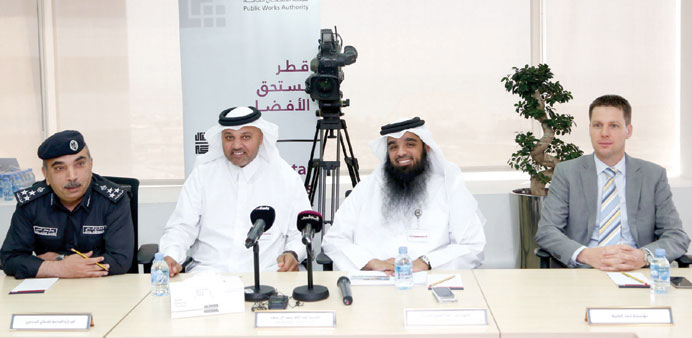By Ramesh Mathew
Staff Reporter
Emergency Vehicle Pre-emption System (EVPS) sensors have been installed at 50 more intersections, mainly across Doha and its neighbourhoods, by the Road Maintenance Department of the Public Works Authority (Ashghal), it was announced yesterday.
With this expansion, a total of 80 traffic intersections have been installed with EVPS sensors, as part of the efforts to considerably reduce the response time to meeting situations arising from varying emergencies.
At a meeting yesterday, Ashghal’s Road Maintenance Department’s Safety Operations and Traffic Control head and senior engineer Abdul Aziz al-Sada said the significant increase in the number of EVPS sensors at intersections would go a long way in helping the ambulances of the Hamad Medical Corporation (HMC) meet emergency situations more effectively than ever before.
“Installation of EVPS sensors at more intersections would not only minimise traffic disruption for ambulances and civil defence vehicles but would also help save as many lives as possible in the event of emergencies,” he explained.
Such emergency vehicles also take into account the safety of the rest of the road users by stopping cross streets traffic before they pass intersections, he pointed out.
The Ashghal official recalled that the first batch of 30 EVPS sensors were installed in various parts of Doha, beginning in April 2014. The first phase also saw 15 ambulances and 10 civil defence vehicles equipped with traffic signals remote control devices.
The EVPS is an advanced system consisting of three units, installed on the traffic signals, described as intersection unit, vehicles (vehicle unit) and the Central Management Software that enables those manning the system devices and units ensure the efficiency of their performance and maintenance.
Those managing and monitoring the system at the main centre and all intersections also generate adequate reports based on their functioning, said al-Sada, while explaining the functioning of the system via GPS/radio antenna devices. The devices, it is learnt, receive green light pre-emption hundreds of metres ahead of a signal on the moving course of an ambulance vehicle/emergency vehicle.
Drivers of emergency vehicles have received adequate training on how to effectively use the new system. A committee comprising officials of the Ashghal, General Directorate of Civil Defence (GDCD) and HMC has been constituted to monitor the functioning of the system, evaluate it and make recommendations and suggestions at regular intervals to improve its performance.
Now apart from the emergency ambulances, the EVPS is fitted mainly in the GDCD fire engines. However, in future, some more ministry of interior vehicles and public transport buses would also be equipped with the system, depending on the growing requirements.
More drivers are being trained on the first batch of the vehicles fitted with the EVPS and on the successful completion of their training, more vehicles would be equipped with the system.
Ministry of Interior official Brigadier Jamal Jafar al-Ajani, HMC’s Ambulance Service executive director Brendon David Morris and Ashghal’s PR head Abdulla al-Saad were also present.

Brigadier al-Ajani, al-Saad, al-Sada and Morris announcing the expansion of the EVPS system yesterday.


